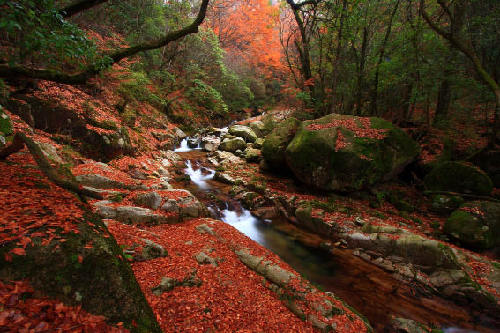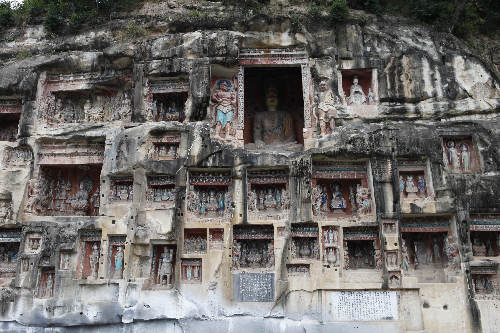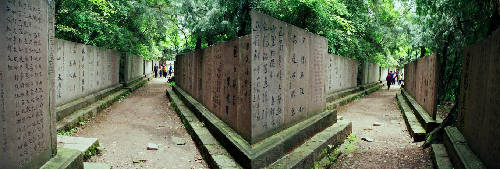Bazhong – A City of Tranquility and Beauty
By WU MEILING & LI ZHOUXI
IN northeastern Sichuan Province, diminutive Bazhong City exudes a pastoral sparkle and tranquility. It makes one wish to blend in with its unique natural environment. A walk through Bazhong, it is said, is like a hazy drizzle that awakens people’s memories.
The picturesque city, resembling a Monet oil painting, lies inlaid within the southern foothills of the towering and extensive Daba Mountains. Situated at the center of three large cities of Chengdu, Chongqing and Xi’an, Bazhong also sits along the dividing line between south and north China. Covering 12,000 square kilometers, the city combines both the grandeur of northern China and the warmth of southern China, with distinctive vistas of mountains and rivers, as well as places of historical and cultural allure. It has also been a historical channel for cultural exchanges between north and south China, witness to the Qin and Han dynasties, the Three Kingdoms, and the Red Army. People here easily sense the pulse and echoes of history.
More than 5,000 years ago the ancient Ba people lived and flourished on this land – and the joss-sticks and candles burning within Baling Village in the high mountains and lofty hills have never been extinguished. The 3,000-year-old ancient Micang Road extended through the Daba Mountains, where the Yellow River civilization and Bashu culture intermingled. Although this road has now been abandoned, related historical memories have always lingered among the people. The most famous tale about this ancient road recalls the early Western Han Dynasty (206 BC - AD 220) prime minister, Xiao He who pursued and persuaded the strategist Han Xin to remain, thus altering the final outcome of the war between the Chu and the Han.
Ancient villages along the route also bear witness to the prosperity of Bazhong. Bazhong was once an important hub for political, economic and cultural exchange between north and south China.
 |
| Yunwu Mountain resplendent in its brilliant fall colors. |
From ancient times, Bazhong possessed strategic consequence, with feudal lords vying for dominion. The Ba people were not only brave and adroit in battle, but also good at singing and dancing. Ba people assisted in numerous ancient wars, including aiding King Wu to defeat Tyrant Zhou, supporting Ying Zheng, the first emperor of the Qin Dynasty (221-206 BC) to unify China, and helping Liu Bang found the Western Han Dynasty. This ancient and mysterious land also gave birth to such eminent persons in history as astronomer Zhang Sixun of the Song Dynasty (960-1279), Wang Jian, first emperor of the Former Shu (907-925), and famous educator Yan Yangchu (1890-1990), among many others.
China was known as a land of poetry, especially during the Tang Dynasty (618-907), when poetry reached its height. Beautiful Bazhong is also a fertile land that has nurtured fine poetry. Famous Tang poets such as Li Bai and Wang Bo all cited Bazhong in their poems. As early as the pre-Qin period, Bayuge, an ancient folk song with love as its main theme, was created by the Ba people, becoming an important feature of Han-style folk songs and ballads.
Amazing Grottoes
During the Sui and Tang dynasties (581-907), not only trade caravans traversed the ancient Micang Road in an endless stream, but also itinerant monks. The picturesque landscape led them to sojourn with no thought of leaving, remaining to produce wall paintings in the grottoes using local natural minerals as pigment. Now known as the Bazhong Grottoes, they are the best examples of painted sculptures from the flourishing Tang Dynasty.
Bazhong enjoys a fine reputation as the “hometown of grottoes,” having an extensive spread of numerous rock caves. The largest and best preserved are the Nankan Grottoes, with 179 numbered caves and about 2,700 Buddhist statues. Most of the statues are found on the eastern cliffs of Nankan Mountain, including Sakyamuni, the Buddhas of the Past, Present and Future, and Maitreya.
 |
| The Nankan Mountain cliff grottoes. |
|
 |
| Inscribed steles on Yinling Mountain. |
People recall, “The Yungang Grottoes are famous for their grandeur, while the Nankan Grottoes are renowned for painted sculptures.” Indeed, while walking towards the peak to view the 200-meter-long cliff, the bright-colored statues sat closely side-by-side offer a magnificent vista. These statues, unifying form and spirit, and perfect in texture and scale, are decorated and painted with natural pigments of green, red, white and blue. The magnificent and splendid grottoes showcase social representations of a flourishing period in the Tang Dynasty. Of course, this resplendent view is not without accretions from later dynasties.
“The Mogao Grottoes are the envy of the world because they are an accumulation of more than 1,000 years,” stated famous Chinese scholar and writer Yu Qiuyu. “To appreciate the Mogao Grottoes is not to look at specimens from 1,000 years ago, but to observe 1,000-year-old living things.” The Bazhong Grottoes are similar. Moreover, these grottoes in the open air have experienced wind and rain over a long history, inspiring emotional responses from visitors, many who prostrate themselves in veneration.
Magnificent Guangwu Mountain
Located in northern Sichuan Province, Guangwu Mountain derives its name from the panorama of clouds and mist curling up throughout the year. Lush with dense vegetation, the beautiful peaks, strangely-shaped rock formations, cliffs, valleys, streams, waterfalls and natural greenery all merge into a complete whole.
The best season to visit Guangwu Mountain is autumn, because the mountain is adorned in a fairytale world with red leaves everywhere. Visitors are awed by the graceful and gorgeous view – a masterwork of elegance.
To appreciate this mountain one needs to take a grand and wide point of view. Guangwu Mountain is the hinterland of the Micang Mountains. If you look at the Micang Mountains on a map of China, they resemble an emerald inlaid into the heart of the country. The Micang Mountains are a transitional zone linking the Qinling Mountains to the west and the Daba Mountains to the east. As an east-west arc of mountains, the northern side of the Micang Mountains is the Hanzhong Plain, an abundant locale in Shaanxi Province, and the southern side is the Sichuan Basin, known as “the land of abundance.” Located in the intersectional zone of cold and warm currents, the Micang Mountains are rich in unique vegetation, rare birds and unusual animals, with a forest coverage of more than 95 percent. If the Micang Mountains are a vast and glorious oil painting of a mountain vista, then Guangwu Mountain is the finishing touch.
Our first impression of Guangwu Mountain was its vastness and abundance, taking us about five hours to drive along the mountain road from its base to the very top. If the Huangshan Mountains are like a bonsai cherished by the heavens, then Guangwu Mountain is a great garden favored by the gods. Taking about a week for an in-depth tour, many visitors return several times, to not only see “the tip of the iceberg” again and again, but for the different vistas during the four seasons.
Services
Economy
- Are You Ready to Perform?
- Beijing’s Green Courtyard
- China’s CSR on the Global Market Fast Track – An Interview with Xu Zongxiang, vice president of China South Locomotive & Rolling Stock Corporation Limited (CSR)
- China’s Changing Development Pattern
- China Accelerates Transformation of Its Economic Development Model
